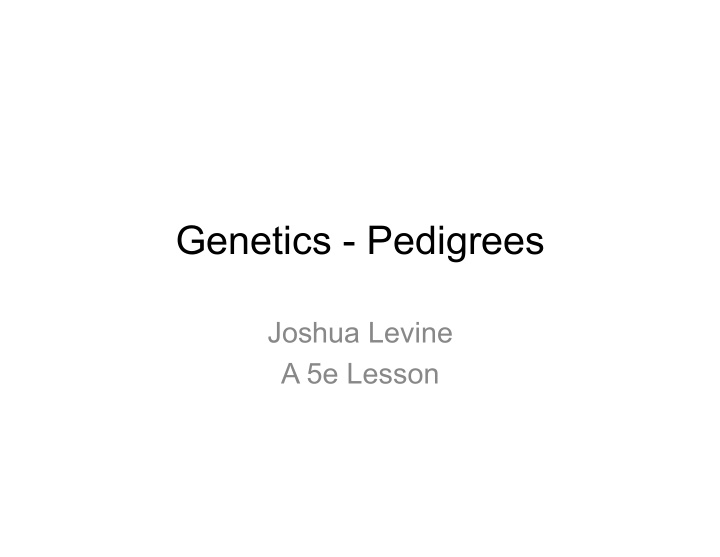



Genetics - Pedigrees Joshua Levine A 5e Lesson
Bell Work • Albinism is a genetic trait characterized by a lack of pigment and caused by inheritance of recessive alleles for a single gene. 1. Draw a Punnett Square for a cross between two adults that are both heterozygous for Albinism. 2. What percentage of this couples children are expected to have the albinism phenotype? 3. If this couple has 2 children, what is the probability that: a) Both will be albino? b) Neither will be albino?
Pedigrees • Pedigrees are “family trees” that show the inheritance of a trait. Conventions?
Royal Hemophilia Pedigree
Building Pedigrees • We are going to build a pedigree for Wet (dominant) versus Dry (recessive) earwax. • Wet allele = W • Dry allele = w • Which genotype(s) will have wet earwax? • Which genotype(s) will have dry earwax?
Part 1: Find a Mate! • Roll dice to determine how many offspring you and your mate will produce. • For each offspring – Determine sex: coin flip • Heads = female • Tails = male – Determine Genotype: each parent contributes one allele to each offspring (everyone starts heterozygous) • Heterozygous parents: flip a coin (heads = W, tails = w) • Homozygous parents: no coin flipping for you, you only have one allele to pass!
Part 2: Next Generation! • “Arrange” a marriage for one of you and your mate’s offspring with another pair’s offspring. • Mate again, using same rules as before. – Dice roll for number of offspring – Coin flip for sex • heads = female • tails = male – Coin flip for heterozygous parents • Heads = W (wet earwax allele) • Tails = w (dry earwax allele)
Part 3: Diagram! • Using proper pedigree conventions, diagram the lineage you have created with your group. • Display “dry earwax” as the trait of interest. Dry Wet
Interpreting Pedigrees • Sometimes we don’t know the underlying genetics of a trait, but we can use pedigrees to figure them out. • Let’s look at some examples…
Cystic Fibrosis (CF) • CF is a disease primarily of the lungs where sodium and chloride are not transported properly. • Given this pedigree, what is the likely mode of inheritance of CF? Why?
Cystic Fibrosis (CF) • What is the probability that if the circled couple has another child, it will have CF?
Continue Worksheet • You may work in groups or alone • PKU • Tongue rolling • DMD • We will go over the answers tomorrow in class!
Closure – Genetic Counseling • Many of the examples we examined today involve diseases that can have adverse effects on quality of life. Imagine you are analyzing a pedigree for a couple that wants to have children, but may adopt because they know there are diseases in their families. What are the pros and cons of knowing the probability of future children having a disease?
END
Bell Work - Answers 1) 2) 25% 3a) 1/16 ( ¼ * ¼ ) 3b) 9/16 ( ¾ * ¾ )
Interpreting Pedigrees - Answers • CF – Recessive, because two unaffected individuals (grandparents) gave birth to an affected offspring, they must both be heterozygous. – 50% • PKU – Recessive – No, parents of circled must be heterozygous, therefore at least one grandparent must also be heterozygous – 1/9 = 2/3 * 2/3 * 1/4
Interpreting Pedigrees - Answers • Tongue Rolling – Dominant – Heterozygous – ¼ = ½ * ½ • DMD – Recessive, sex-linked – X chromosome – ¼ ( ½ probability that mom is carrier * ½ probability that she will pass on DMD allele) – 0 (females can not develop X linked recessive unless their father had the disease and mother was a carrier)
Recommend
More recommend